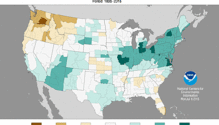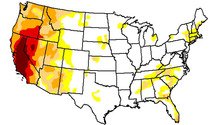Close
by Dan Putnam,Extension Forage Agronomist,University of California-Davis,With alfalfa acreage at the lowest level in 50 years, lack of water remains the key issue for alfalfa growers
By Glenn Shewmaker Extension Forage Specialist University of Idaho May stocks of hay are up in Idaho, but the untold story is that much of it is junk hay. We had dry weather up until it was time to c
This week we first take a look at what was in the form of the June precipitation map for the U.S. Count yourself unlucky if you reside in those areas that set new wetness records; and even more
In eastern Idaho last week, one sale on Supreme alfalfa hay brought $200 fob the stack. While there weren’t any actual sales reported on Fair quality (feeder hay), there were bids of $70 per ton
By Phil Kaatz,Forages & Field Crops Educator,Michigan State University-Extension, Ev Thomas, Agronomist Oak Point Agronomics, New York, Dennis Hancock
A picture is worth a thousand words and what topic is more pertinent to haymaking than weather? Here are this week's weather maps from the National Weather Service. It's still dry in the West and st
by Marvin Hall Extension Forage AgronomistPenn State University First-cut grass harvest is being completed after several weeks of rain delays. In general, grass yields have been about 25 to 35 percent
Hay report after hay report from many parts of the country (sans Southern California) bemoans the impact that massive amounts and/or frequency of rain has had on trying to harvest high-quality
Rainy weather from mid-May to mid-June and with forecasts of above 100° temperatures over the next 10 days, supplies of premium and supreme alfalfa hay are well below normal in the West
by Dan UndersanderProfessor of AgronomyUniversity of Wisconsin-Madison, Madison, Wis by Dan PutnamStatewide Alfalfa & Forage Extension SpecialistDepartment of Agronomy & Range Scien
By Glenn Shewmaker Extension Forage Specialist University of Idaho May stocks of hay are up in Idaho, but the untold story is that much of it is junk hay. We had dry weather up until it was tim
After dry conditions in the West during the first few months of 2015, things changed in May. Some areas received record rainfall, which helped bring needed moisture but brought in an unstable weather pattern
Forages & Field Crops Educator, Michigan State University-Extension Michigan survived the winter with little reported damage due to winterkill or heaving. First cutting began the third week o
..
Visit our partner publications:
Hoard's Dairyman | Journal of Nutrient Management









